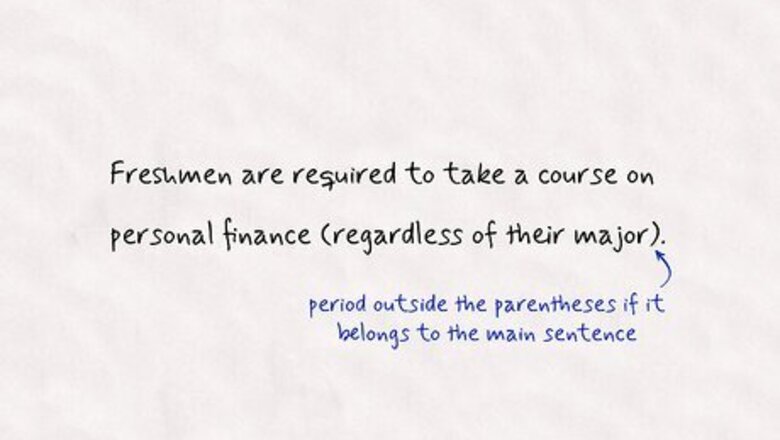
views
When Periods Go Outside Parentheses
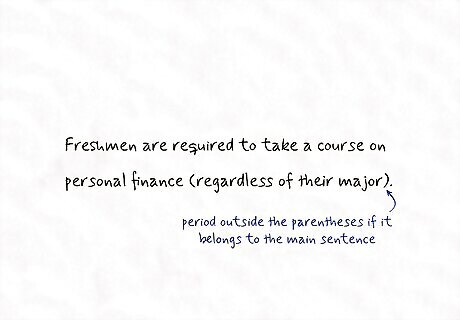
Place the period outside the parentheses if it belongs to the main sentence. Generally, if you have a statement in parentheses, it's not going to have a period at the end of it, even if it's a complete sentence. As long as the parenthetical statement occurs inside another statement, that period is reserved for the main sentence. Example: "Freshmen are required to take a course on personal finance (regardless of their major)." Here, the period goes outside the parentheses because it's the terminal or ending punctuation of the main sentence and the parenthetical is not a complete sentence that is intended to stand alone. Example: "The package (we never received a tracking number) arrived today." Here, there is no period inside the parentheses even though the words enclosed in parentheses form a complete sentence because the parenthetical is part of the main sentence. Note that the statement isn't capitalized either. Periods can be used for other purposes, such as after initials. But when you're using them as terminal punctuation to end a sentence, that sentence can only have one period.
When Periods Go Inside Parentheses
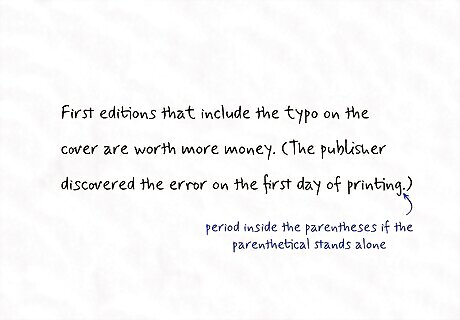
Place the period inside the parentheses if the parenthetical stands alone. This rule only applies when the parenthetical statement is a complete sentence that stands alone by itself and isn't enclosed in another sentence. Often, you can rewrite the same information so that it would work either as an independent sentence or as part of a previous sentence. Example: "First editions that include the typo on the cover are worth more money. (The publisher discovered the error on the first day of printing.)" Here, the period goes inside the closing parenthesis because the parenthetical statement is a standalone sentence. Note that the first word is also capitalized, just as if it were any other sentence. If you rewrite the parenthetical to become part of a previous sentence, remember that a single sentence only gets one period—and that belongs to the main sentence.
Rules for Other Punctuation with Parentheses
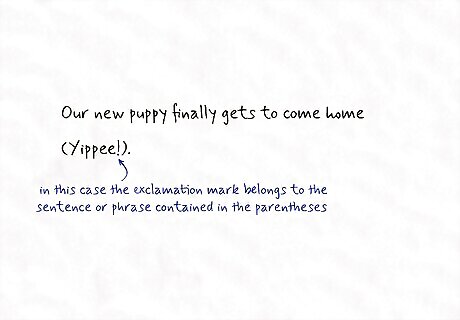
Put exclamation and question marks inside the parentheses. Sometimes, parentheses are used to set off an interjection or other phrase that differs in tone from the main sentence. When this happens, the appropriate punctuation mark goes inside the parentheses because that mark belongs to the sentence or phrase contained in the parentheses. The main sentence still gets a period at the end as its terminal punctuation, regardless of where the parentheses occur in the sentence. Example: "Our new puppy finally gets to come home today (Yippee!)." Here, you have both an exclamation mark and a period. The period belongs to the main sentence while the exclamation mark belongs to the parenthetical statement. In this situation, the first letter is capitalized, as though it were any other sentence or interjection. Exclamation and question marks are terminal punctuation, so if you use one of those, you use capitalization too.
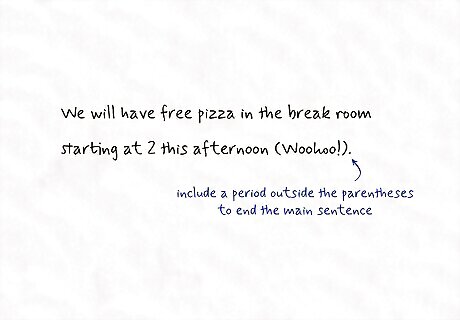
Include a period outside the parentheses to end the main sentence, even if the parenthetical includes other punctuation. When you have an exclamation or question mark inside the parentheses, it doesn't apply to your main sentence. That means you still need terminal punctuation. It might look a little weird to have all those punctuation marks in a row like that, but it's correct! If it bugs you too much, you might re-write the sentence so that it doesn't end with the parenthetical phrase. Example: "We will have free pizza in the break room starting at 2 this afternoon (Woohoo!)."
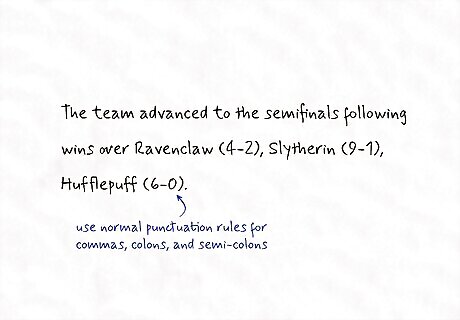
Use normal punctuation rules for commas, colons, and semi-colons. Not all punctuation marks signal the end of a sentence. Non-terminal punctuation marks, such as commas, semi-colons, and colons, just signify pauses of varying lengths. Generally, you'd only follow the parentheses with a non-terminal punctuation mark if you'd use that punctuation mark in the sentence without the parentheses. Example: "The team advanced to the semifinals following wins over Ravenclaw (4-2), Slytherin (9-1), and Hufflepuff (6-0)." Here, commas are used immediately after the closing parenthesis because that's where commas would be included in the original series even if the parentheses were removed. If it helps, take the parentheses out and punctuate the main sentence first, then drop the parentheses back in. When it comes to non-terminal punctuation within the parentheses, follow the same rules as you normally would for a sentence.
When to Use Parentheses
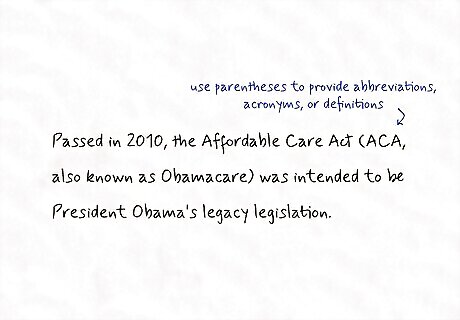
To provide abbreviations, acronyms, or definitions This type of information might not be strictly necessary and it doesn't change the meaning of your main sentence. It just helps your reader better understand what you're writing. By setting it off in parentheses, readers who already know the information can more easily skim over it. Example: "Passed in 2010, the Affordable Care Act (ACA, also known as Obamacare) was intended to be President Obama's legacy legislation." Here, the parentheses include both the official acronym and the popular name of the legislation. If the abbreviation or acronym includes periods and the parenthetical phrase is at the end of the sentence, you'd have 2 periods—one inside and one outside the closing parenthesis. Example: "He planned to meet her in the morning (after 7 a.m.)." This doesn't violate the rule that a sentence can only have one period because the periods associated with the abbreviation aren't terminal punctuation.
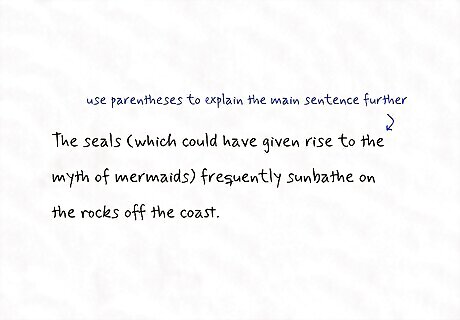
To include detail that explains the main sentence further Sometimes you have extra information about something that's somewhat tangential but still interesting. Parentheses create a sort of bubble for this information. Readers can understand the main sentence perfectly well without the information, but the information adds something to their experience—a little extra color, maybe. Example: "The seals (which could have given rise to the myth of mermaids) frequently sunbathe on the rocks off the coast."
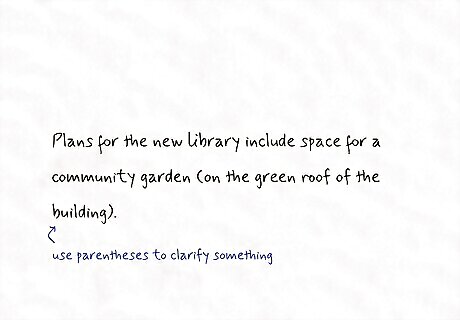
To clarify something in the main sentence Here, there's a word or phrase in your main sentence that you feel the need to clarify, but the information doesn't relate directly to the subject of the sentence. By putting your clarification in parentheses immediately after the word or phrase you want to clarify, you alert your readers to the purpose of that information. Example: "Plans for the new library include space for a community garden (on the green roof of the building)."
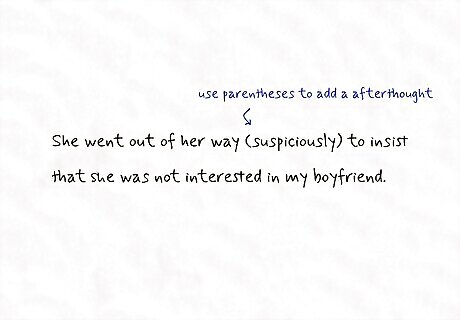
To add a digression or afterthought Particularly in conversational or personal writing, you'll often have little comments that you want to make in the margins—think of these parentheticals as something you'd say as an aside. They're not necessarily important to the sentence but they do add personality and flavor. Example: "She went out of her way (suspiciously) to insist that she was not interested in my boyfriend."
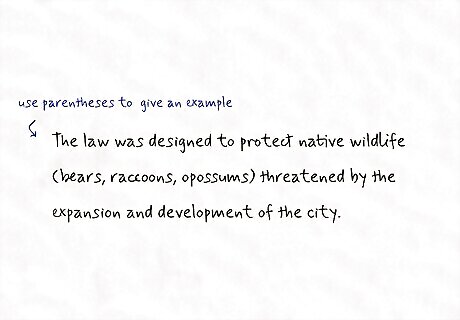
To give an example of something in the main sentence If you're talking about broad categories of things in your main sentence, you might want to use parentheses to list some examples. While they're not necessary, they can help readers who might not be as familiar with the larger category. Example: "The law was designed to protect native wildlife (bears, raccoons, opossums) threatened by the expansion and development of the city."
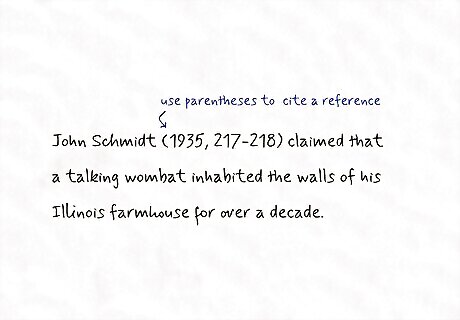
To cite a reference for the main sentence This use of parentheses is seen most often in academic writing. Some citation manuals require in-text parenthetical citations whenever you quote or paraphrase information from another source. The punctuation rules for parentheses in this case depend on the specific rules of your citation manual, but typically the period stays outside the parentheses. You might also use parentheses for a cross-reference, such as if you want to refer your readers to a different page, or to a table or figure.
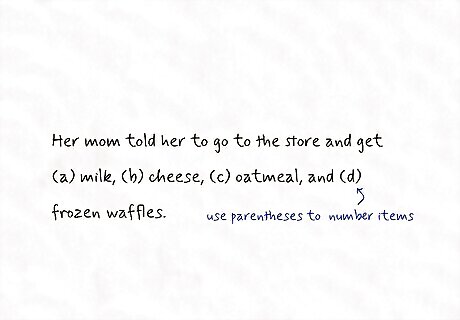
To set off the letters or numbers of items in a list Long lists often look neater and are easier to reference when you provide numbers or letters for each item. If the list occurs in a regular sentence, put parentheses around each number or letter. Example: "Her mom told her to go to the store and get (a) milk, (b) cheese, (c) oatmeal, and (d) frozen waffles." Note that the series is punctuated with commas the same as it would be if you took all of those parentheses out.


















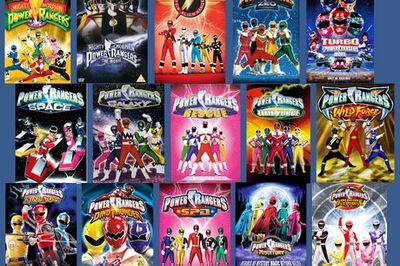

Comments
0 comment